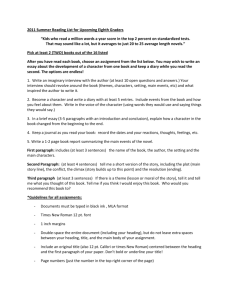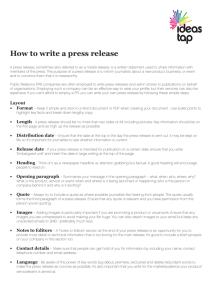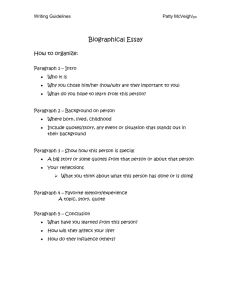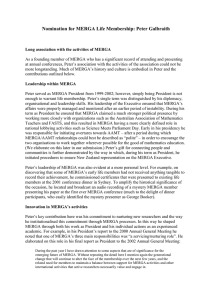MTED style sheet/template
advertisement
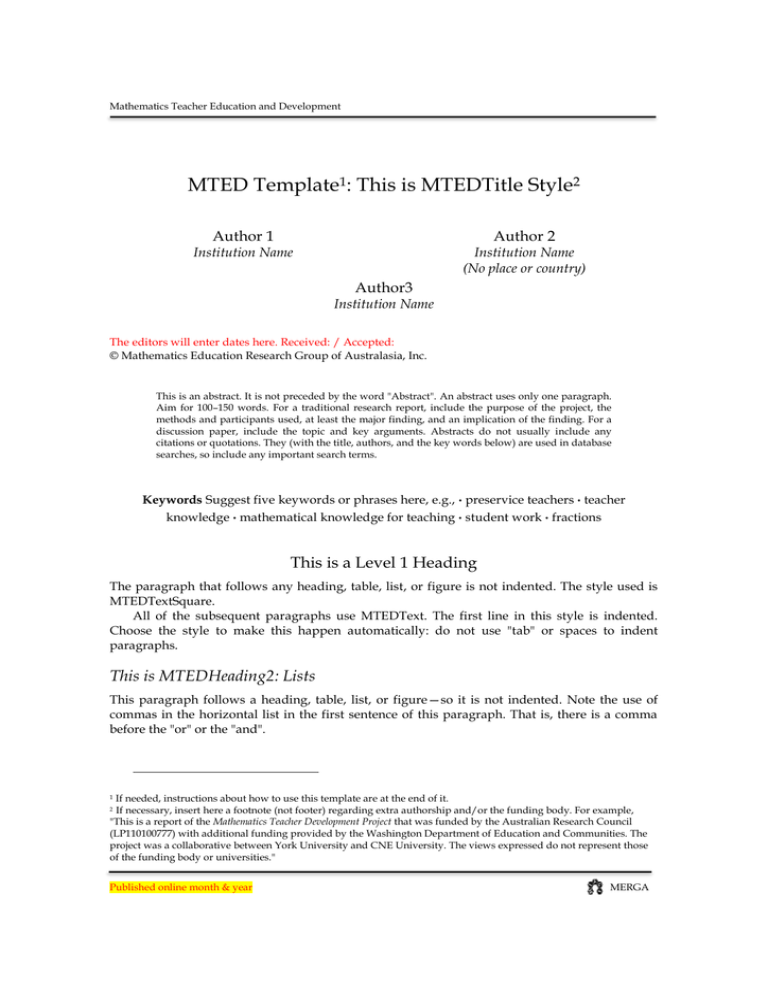
Mathematics Teacher Education and Development MTED Template1: This is MTEDTitle Style2 Author 1 Author 2 Institution Name Institution Name (No place or country) Author3 Institution Name The editors will enter dates here. Received: / Accepted: © Mathematics Education Research Group of Australasia, Inc. This is an abstract. It is not preceded by the word "Abstract". An abstract uses only one paragraph. Aim for 100–150 words. For a traditional research report, include the purpose of the project, the methods and participants used, at least the major finding, and an implication of the finding. For a discussion paper, include the topic and key arguments. Abstracts do not usually include any citations or quotations. They (with the title, authors, and the key words below) are used in database searches, so include any important search terms. Keywords Suggest five keywords or phrases here, e.g., . preservice teachers . teacher knowledge . mathematical knowledge for teaching . student work . fractions This is a Level 1 Heading The paragraph that follows any heading, table, list, or figure is not indented. The style used is MTEDTextSquare. All of the subsequent paragraphs use MTEDText. The first line in this style is indented. Choose the style to make this happen automatically: do not use "tab" or spaces to indent paragraphs. This is MTEDHeading2: Lists This paragraph follows a heading, table, list, or figure—so it is not indented. Note the use of commas in the horizontal list in the first sentence of this paragraph. That is, there is a comma before the "or" or the "and". If needed, instructions about how to use this template are at the end of it. If necessary, insert here a footnote (not footer) regarding extra authorship and/or the funding body. For example, "This is a report of the Mathematics Teacher Development Project that was funded by the Australian Research Council (LP110100777) with additional funding provided by the Washington Department of Education and Communities. The project was a collaborative between York University and CNE University. The views expressed do not represent those of the funding body or universities." 1 2 Published online month & year MERGA The editors will enter short title here The editors will enter author(s) here. A numbered list is made by using the MTEDText style and then choosing the "numbered" format button in MSWord. If the points each follow on from a leader phrase, each point: 1. starts with small letters because the sentence is being continued (although your grammar checker will indicate otherwise); 2. finishes with a semi-colon; and 3. if it is the last point, is preceded by the word "and" and completed with a full stop, as in this example. You may need to use a tab after the number, letter, or bullet point that initiates a listed point. Notice how the paragraph that follows a list or dot points is MTEDTextSquare. The same rules used for numbered points apply to dot points. Normally, these are also part of the leader sentence. Read the leader with each individual point to make sure that the grammar is right. Like numbered points, if the leader sentence is complete on its own then each of the points needs to be a complete sentence with a capital letter and a full stop. Citations, Referencing, and Transcripts MTED uses APA style and this is particularly important for citations and referencing. If you are not sure about the necessary details, check the APA style guide, at http://owl.english.purdue. edu/owl/section/2/10/. Citations are presented in alphabetical order, not year order (Clarke & Hollingsworth, 2002, 2005; Edwards, 1994). Note the different types of instances when et al. may be used, and note that italics are not used in et al. but there is one full stop in it (i.e., as well as e.g., also have full stops and are followed by commas—but it is best to write the full words.) Quotations This is the quotation style — MTEDQuote. Note that it has no quotation marks. This style is used for quotations of thirty words or more. It has a page number at the end of the quote. The author(s) and date may be cited in the same bracket, or in the paragraph that introduces the quote. In a set-apart quote like this, the full stop comes before the page number. (p. 221) Shorter quotes, with fewer than thirty words, are incorporated into sentences. The author, date, and page number follow the quotation in brackets, followed by the full stop. That is, the quote is part of the sentence. If any quote does not start with a capital letter, it may be "run on" as part of the sentence or else started with an ellipsis. For example, both of the following are correct: (a) Another related issue is the "tension between participants' views of themselves as adult learners of mathematics and their practice with young children" (Brown & Borko, 1992, p. 215). (b) Brown and Borko (1992) noted a "… tension between participants' views of themselves as adult learners of mathematics and their practice with young children" (p. 215). Note that there is always a space after p. (page) and pp. (pages), in citations as well as in references. Text omitted in a quotation is shown by an ellipsis: three full stops not separated by spaces. The three dots are separated by a single blank space from the preceding and following text, which might be a full stop or other punctuation mark. Single quote marks are used rarely in APA style: use double quotes except for quotes within quotes. MTED uses straight quotes, not smart quotes. MERGA The editors will enter short title here The editors will enter author(s) here. Figures and Tables Normally, two headings do not follow each other without some text between them. Figures. This is the only other level of heading used in MTED papers: MTEDHeading3. That is, aside from the title of an article, only three levels of heading are used: (a) Heading 1 for the 34 main sections of your paper; (b) Heading 2 for sub-major sections; and (c) Heading 3 for minor headings. (Note how letters and semi colons were used for that in-sentence list.) The Heading 3 style, MTEDHeading3, inserts a small space above the paragraph, but you will need to make the heading itself into italics. Note that major words in heading 3 are not capitalised. If you are creating figures from scratch, please use Palatino 10 as the font. If you are scanning a figure, the result must be clear. It may be necessary to re-draw a figure, and if that is the case, write "(redrawn by author)" in the citation. You need to explain what a figure is in its preceding paragraph, with reference to the Figure number (see Figure 1). If a figure is copied, the citation needs to include a page number. If a figure is varied in any way, this needs to be explained in the paragraph, and the word "adapted is added to the Figure Caption. The figure itself should be no wider than the MTEDText paragraphs, and its style is MTEDFigure. The style to use for the figure's caption is MTEDFigureCaption. Here is an example of a figure and its caption (see Figure 1). Figure 1. Three-year-old child, using informal measurement. Note where italics are used in the figure caption, and that it finishes with a full stop. If children's faces are used in your figures, please submit to the MTED Editor for each child the child's name, the name of the photographer, and a parent's signature and date under a sentence that gives permission for publication of the photo(s) in a journal on-line. Tables. The text used in tables is all MTEDTableText style. Avoid italics and/or bold if possible. No vertical lines are used: just columns with hidden lines. Three horizontal lines are used: a 3/4pt line at the top and bottom of the heading cells as well as a ¾pt bottom line (see Table 1). The paragraph before the table is used to describe it, with direct reference to it. Discussion of the content of the table should follow it. The table caption has two lines. MTEDTableTitle1 gives the number of the table, while MTEDTableTitle2 gives the title of the table, using capitals letters for the main words. In contrast to figure captions, neither line has a full stop. MERGA The editors will enter short title here The editors will enter author(s) here. The following is an example of a table (see Table 1). Note that even though keeping it as one table leaves a space here, we have not split the table. An Example of a Table Lessons (Time) Level / Number of Students* Topic Strand Lesson 1 (60 minutes) Grade 2 / 26 Triangles Geometry Lesson 2 (30 minutes) Grade 4 / 30 Kilometres Measurement *This is MTEDTableFooter. Use only if necessary. (See APA style guide) Transcripts. When you wish to quote dialogue from one only person, use the block quote format. However, a dialogue involving more than one person uses MTEDTranscript style. Type the name of the speaker, followed by a colon and a tab, then type the words they said. Teacher: You said eighteen times five is ninety? What was your thinking? Child: Well five times twenty is a hundred. But it is only eighteen so I have to take off ten. Teacher: Ten? Child: That's five times two. Like, eighteen is two less than ten. Spelling, Grammar, and Formatting of the Document Paper and margins Choose A4 paper, and use the following settings. Top margin: 3.9 cm; Bottom margin: 3.9 cm; Inside margin: 4.5 cm; Outside margin: 4.5 cm; Gutter: 0 cm; Header: 3 cm; Footer: 3 cm; and Mirrored margins. Do not write in the header or the footer. Do not use footnotes other than explained on p. 1: use endnotes if really necessary. Page numbers may be used in a submitted article but will be removed in the author's proof copy, so do not make cross-references such as "see page 14". Spelling MTED uses Australasian (AUS) academic English. Please spell and grammar check your document accordingly (i.e., choose the correct dictionary from the Spell check options). If this is not an option, use UK English. In particular, spell words like “visualise” with the ending -ise, not -ize, and words like “centre” with the ending -re, not –er. Note the spelling of "behaviour". Do not assume that local cities are well-known to the reader: give the state and country where necessary. MERGA The editors will enter short title here The editors will enter author(s) here. Numbers. Whole numbers less than 10 should be written out in word form, such as four or seven. One exception to this rule is when a sentence starts with a number, when the number is always written out as a word. For example, "Fifteen students were sick; two teachers went home." If possible, avoid starting a sentence with a long number. Place a zero before the decimal point in all numbers less than 1 (e.g., “p < 0.05”). Returns and spaces The heading and other styles have the correct spacing built into them. There should be no double returns in your document (i.e., Enter/Enter or Return/Return). Single spaces are used between words and after full stops and other punctuation marks. If a broader space is needed, such as for lining up figures, use tabs. Acknowledgements Include acknowledgements in a separate paragraph, headed Acknowledgments (in MTEDHeading1 style), immediately before the reference list. Referencing Include a reference list, headed References (in MTEDHeading1 style) before any appendices. On-line APA guides have examples of most sorts of references. Check that all works cited in the text appear in the reference list, and vice versa, and that there are no references listed that are not mentioned in the text. Note that publishers' place names are cities, not countries or suburbs. If these are capital cities (national or state), just the city name is used; but if they are not cities that are the capital of a country, state or region then the country or an abbreviation of a state/region is given. If there could be confusion, a country or state is used (e.g., Cambridge, UK; Cambridge, MA). Capital letters are used for state/region abbreviations (e.g., VIC, CA, WA, AB). Some examples of references follow. Adler, J., & Davis, Z. (2006). Opening another black box: Researching mathematics for teaching in mathematics teacher education. Journal for Research in Mathematics Education, 37, 270–296. Ball, D. L. (1989). Breaking with experience in learning to teach mathematics: The role of a preservice methods course. Retrieved May 11, 2013, from http://ncrtl.msu.edu/http/ipapers/html/pdf/ip8910.pdf Ellerton, N., & Clements, K. (1997). Pencil-and-paper mathematics tests under the microscope. In F. Biddulph & K. Carr (Eds.), People in mathematics education (Proceedings of the 20th annual conference of the Mathematics Education Research Group of Australasia, pp. 155–162). Rotorua, NZ: MERGA. Mitchelmore, M. C., & White, P. (1995, April). Development of the angle concept by abstraction from situated knowledge. Paper presented at the annual meeting of the American Educational Research Association, San Francisco, CA. (ERIC Document Reproduction Service No. ED 416 066) Outhred L., Farrell, J., & Cotter, K. (1996, July). How well do student teachers integrate science and mathematics concepts? A pilot study. Paper presented to Working Group 1 at the 8th International Congress on Mathematical Education, Seville, Spain. Owens, K. D. (1994). Visualisation as an aspect of spatial problem solving. In R. Killen (Ed.), Educational research: Innovation and practice (Proceedings of the annual conference of the Australian Association for Research in Education) [On-line]. Available: www.swin.edu.au/AARE/conf94.html File: OWENK94.161 Publication manual of the American Psychological Association (4th ed.). Washington, DC: American Psychological Association. Sullivan, P., & Mousley, J. (1998). Conceptualising mathematics teaching: The role of autonomy in stimulating teacher reflection. In A. Olivier & K. Newstead (Eds.), Proceedings of the 22nd annual MERGA The editors will enter short title here The editors will enter author(s) here. conference of the International Group for the Psychology of Mathematics Education (Vol. 4, pp. 105–112). Stellenbosch, South Africa: Program Committee. Appendices Use appendices only if really necessary. Usually it is not necessary to append a whole test or other research instrument. Further Information Please check a website such as http://owl.english.purdue.edu/owl/section/2/10/ to search for any further APA-style information that you are not sure about. Authors First author's name First author's institutional address email: First author's email address Second author's name Second author's institutional address email: Second author's email address Third author's name Third author's institutional address email: Third author's email address Add more authors here as needed. MERGA Appendix: How to Use This Template This template is to be used for all articles submitted to the journal, Mathematics Teacher Education and Development. Use it as a style sheet to write your MTED submission, or if you have written the paper using another style sheet: Delete any section breaks from your article, unless they delineate large tables that will need "landscape" format. Copy your article except for its last word. Paste your article at the start of this article, above its title. Type in its last word. (Invisible formatting and styles instructions are attached to the final word, and you do not want these carried across.) Work through your document, changing it to MTED styles only. That is, for each element (paragraph or other feature) of your document, choose a style whose name starts with or includes "MTED". Note that MTED uses only three heading levels. Do not change the MTED styles in any way, even if they may look a bit strange to you. DO NOT change the font size, character spacing, or line spacing. Do not worry about where page breaks, figures, or breaks in tables fall: it is all right if there is a large space in front of them. Just insert figures or tables following the paragraph where they are mentioned. (The editors may make minor changes here.) Copy and paste the authors' details section from the bottom of the template and change them to your details. When you no longer need it, delete the template and this page. Published online month & year MERGA

